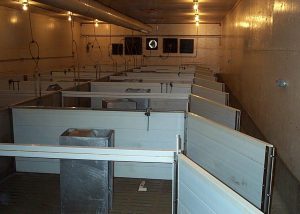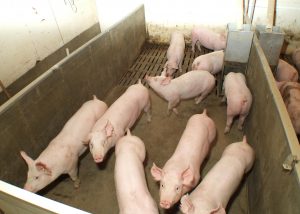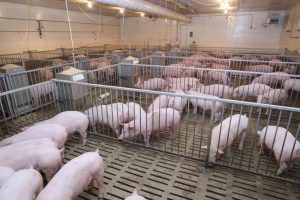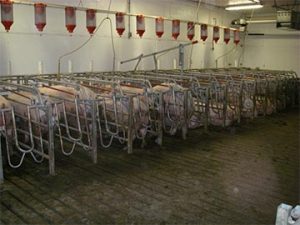The fully equipped surgery room is used to prepare animals for a variety of studies, from changes in blood profiles to monitoring the digestion of various feedstuffs. Associated with the surgery room are the Preparation and Recovery rooms. There are two small Experimental Rooms, located near the surgery room. These rooms are shells, with independent heating and ventilation that are adaptable to a wide array of research using sows, piglets, or growing pigs. The rooms measure 6.4m x 6.4m and can be fitted with penning to suit the needs of particular studies. Two Metabolic Rooms can accommodate up to 20 metabolism crates each.
Grower-Finisher Facilities
 1,672 spaces
1,672 spaces- one metabolism room with 20 crates per room
- 6 semi-intensive rooms, with 20 pens (5 pigs/pen) per room
- 6 commercial rooms, with 6 pens (10 pigs/pen) per room
- 2 engineering rooms, with 10 pens (14 pigs/pen) per room
Intensive Facilities
 Two Intensive Rooms can each house 76 grower/finisher pigs in fully slatted, individual pens. Each room measures 19.8m x 7m and has 4 rows of 19 pens. The rooms are equipped with nipple drinkers and single space feeders.
Two Intensive Rooms can each house 76 grower/finisher pigs in fully slatted, individual pens. Each room measures 19.8m x 7m and has 4 rows of 19 pens. The rooms are equipped with nipple drinkers and single space feeders.
Semi-Intensive Facilities
- There are eight Semi-intensive Rooms that can each house 5 pigs/pen
- with 20 pens/room for pigs from 8 weeks of age to market.
Commercial Facilities
 There are six Commercial Rooms that can each house 144 grower/finisher pigs per production cycle. Each room measures 14.3m by 10.7m and contains 6 pens, each capable of holding 12 pigs. The rooms have partially slatted floors and are equipped with nipple drinkers and automatic feeders.
There are six Commercial Rooms that can each house 144 grower/finisher pigs per production cycle. Each room measures 14.3m by 10.7m and contains 6 pens, each capable of holding 12 pigs. The rooms have partially slatted floors and are equipped with nipple drinkers and automatic feeders.
Engineering Facilities
 There are two Engineering Rooms that measure 14.3m x 11m each and have fully slatted floors throughout. The rooms are equipped with wet/dry feeders and the spindle penning which can be easily moved for frequent changes in pen size, shape and location. There are nine fully independent manure channels within the rooms that allow for a variety of studies on manure storage, treatment and composition.
There are two Engineering Rooms that measure 14.3m x 11m each and have fully slatted floors throughout. The rooms are equipped with wet/dry feeders and the spindle penning which can be easily moved for frequent changes in pen size, shape and location. There are nine fully independent manure channels within the rooms that allow for a variety of studies on manure storage, treatment and composition.
Nursery
- There are five identical Nursery all-in-all-out rooms. Each room has 12 pens available for research, capable of holding 10 pigs/pen, for a total of 120 pigs. The 12 pens can be easily split into 24 pens, which will hold 4 pigs/pen enabling different research requirements to be accommodated.
Sow Barn
 The Sow Research Unit houses a 300 sow herd. Opened in July 2008, The 126′ x 203′ barn includes breeding, gestation, farrowing, gilt development, lab facilities and a small office.
The Sow Research Unit houses a 300 sow herd. Opened in July 2008, The 126′ x 203′ barn includes breeding, gestation, farrowing, gilt development, lab facilities and a small office.- The Sow Research Unit has five farrowing rooms to accommodate a shift to four week weaning. When the industry was surveyed prior to designing the new barn in Spring 2007 the suggestions to go to four week weaning came from many producers.
- Specifications: pen 72″ x 108″, stall 64″ to 76″, 12″ adjustment in rear crate width.
Farrowing Facilities
- Farrowing room of 16 crates with semi-automated feeding. Extra wide 6′ alley between rows of crates accommodates containers for experimental diets and feed carts as well as weighing, handling and processing activities.
Gestation Facilities
- Free access stalls allow sows the option to seek protection of a stall or choose to be part of the group. Two rows of 16 stalls (2 weeks breeding) share the 10′ x 35′ slatted area between the rows.
- Specifications: 80″ long x 26″ wide
- Free access swine stalls
Other research facilities available through Prairie Swine Centre
- Commercial sites adapted to research (past studies have included disease challenge, immunization, etc)
- Commercial-sized disease challenge grower-finisher
- Commercial-sized nursery 500-2000 head
Biosafety Level 2
Available for nursery, grower-finisher, and sows. Is a place to do work with infectious agents that can cause human or animal disease but under normal circumstances are unlikely to be a serious hazard to lab workers, livestock, or the environment (ex. TGE, many salmonella)
Biosafety Level 3
A place to do work with infectious agents that are pathogens that usually cause serious human or animal disease, or which can result in serious economic consequences, but do not ordinarily spread by casual contact (ex. anthrax, tuberculosis)

